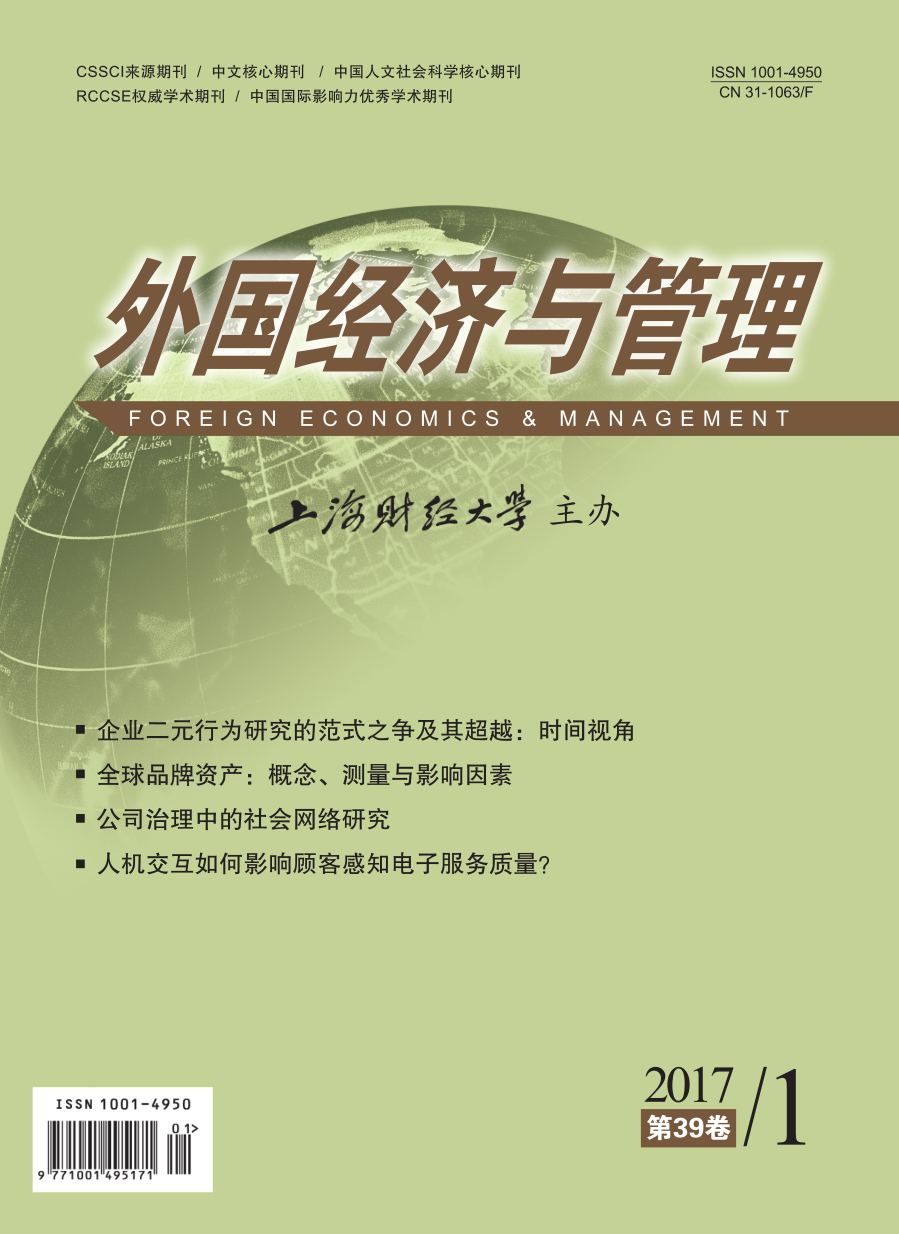人机交互如何影响顾客感知电子服务质量是电子服务型企业需要思考的重要问题。整合服务主导逻辑与任务技术匹配理论的观点,本文构建概念模型,对634名网上银行用户进行问卷调查,结果表明:人机交互是由三个基本因素(技术功能性、任务常规性、顾客技术准备度)和两个核心因素(任务常规性与技术功能性的交互、顾客技术准备度与技术功能性的交互)构成的有序统一体;三个基本因素是顾客感知电子服务质量的贡献因子,两个核心因素起阻碍作用,但顾客技术准备度与技术功能性的交互所起的阻碍作用仅在广东样本中显著;任务技术匹配在三个基本因素和一个核心因素(任务常规性与技术功能性的交互)对顾客感知电子服务质量的影响中起中介作用,它在另一核心因素与顾客感知电子服务质量之间所起的中介作用仅在广东样本中显著。研究结论丰富了电子服务质量前因的理论积累,推动了任务技术匹配理论在服务科学领域发展与深化,对电子服务型企业改善服务接触界面、提升电子服务质量具有指导意义。
人机交互如何影响顾客感知电子服务质量?--基于广东、广西634个样本的实证研究
摘要
参考文献
1 陈钰芬.开放式创新的机理与动态模式研究[D].杭州:浙江大学, 2007:98-99.
10 Bitner M J. Service and technology:Opportunities and paradoxes[J]. Managing Service Quality, 2001, 11(6):375-379. DOI:10.1108/09604520110410584
11 Cao Q, Gan Q W, Thompson M A. Organizational adoption of supply chain management system:A multi-theoretic investigation[J]. Decision Support Systems, 2013, 55(3):720-727. DOI:10.1016/j.dss.2013.02.003
12 D'Ambra J, Wilson C S, Akter S. Application of the task-technology fit model to structure and evaluate the adoption of E-books by Academics[J]. Journal of the American Society for Information Science and Technology, 2013, 64(1):48-64. DOI:10.1002/asi.22757
13 Fassnacht M, Koese I. Quality of electronic services:Conceptualizing and testing a hierarchical model[J]. Journal of Service Research, 2006, 9(1):19-37. DOI:10.1177/1094670506289531
14 Goodhue D L. Understanding user evaluations of information systems[J]. Management Science, 1995, 41(12):1827-1844. DOI:10.1287/mnsc.41.12.1827
15 Goodhue D L, Thompson R L. Task-technology fit and individual performance[J]. MIS Quarterly, 1995, 19(2):213-236. DOI:10.2307/249689
16 Koufteros X, Babbar S, Kaighobadi M. A paradigm for examining second-order factor models employing structural equation modeling[J]. International Journal of Production Economics, 2009, 120(2):633-652. DOI:10.1016/j.ijpe.2009.04.010
17 Liljander V, Gillberg F, Gummerus J, et al. Technology readiness and the evaluation and adoption of self-service technologies[J]. Journal of Retailing and Consumer Services, 2006, 13(3):177-191. DOI:10.1016/j.jretconser.2005.08.004
18 Lindgren I, Jansson G. Electronic services in the public sector:A conceptual framework[J]. Government Information Quarterly, 2013, 30(2):163-172. DOI:10.1016/j.giq.2012.10.005
19 Ma C M, Chao C M, Cheng B W. Integrating technology acceptance model and task-technology fit into blended e-learning system[J]. Journal of Applied Sciences, 2013, 13(5):736-742. DOI:10.3923/jas.2013.736.742
20 Muller D, Judd C M, Yzerbyt V Y. When moderation is mediated and mediation is moderated[J]. Journal of Personality and Social Psychology, 2005, 89(6):852-863. DOI:10.1037/0022-3514.89.6.852
21 Parasuraman A. Technology readiness index (Tri):A multiple-item scale to measure readiness to embrace new technologies[J]. Journal of Service Research, 2000, 2(4):307-320. DOI:10.1177/109467050024001
22 Piercy N. Online service quality:Content and process of analysis[J]. Journal of Marketing Management, 2014, 30(7-8):747-785. DOI:10.1080/0267257X.2013.839571
24 Shriver S K, Nair H S, Hofstetter R. Social ties and user-generated content:Evidence from an online social network[J]. Management Science, 2013, 59(6):1425-1443. DOI:10.1287/mnsc.1110.1648
26 Westjohn S A, Arnold M J, Magnusson P, et al. Technology readiness and usage:A global-identity perspective[J]. Journal of the Academy of Marketing Science, 2009, 37(3):250-265. DOI:10.1007/s11747-008-0130-0
27 Taherdoost H, Sahibuddin S, Jalaliyoon N. Features' evaluation of goods, services and e-services; electronic service characteristics exploration[J]. Procedia Technology, 2014, 12:204-211. DOI:10.1016/j.protcy.2013.12.476
28 Vargo S L, Lusch R F. Service-dominant logic:Continuing the evolution[J]. Journal of the Academy of Marketing Science, 2008, 36(1):1-10. DOI:10.1007/s11747-007-0069-6
30 Zhao X D, Huo B F, Selen W, et al. The impact of internal integration and relationship commitment on external integration[J]. Journal of Operations Management, 2011, 29(1-2):17-32. DOI:10.1016/j.jom.2010.04.004
引用本文
李雷, 赵霞, 简兆权. 人机交互如何影响顾客感知电子服务质量?--基于广东、广西634个样本的实证研究[J]. 外国经济与管理, 2017, 39(1): 96–113.
导出参考文献,格式为:






 7452
7452  9687
9687

